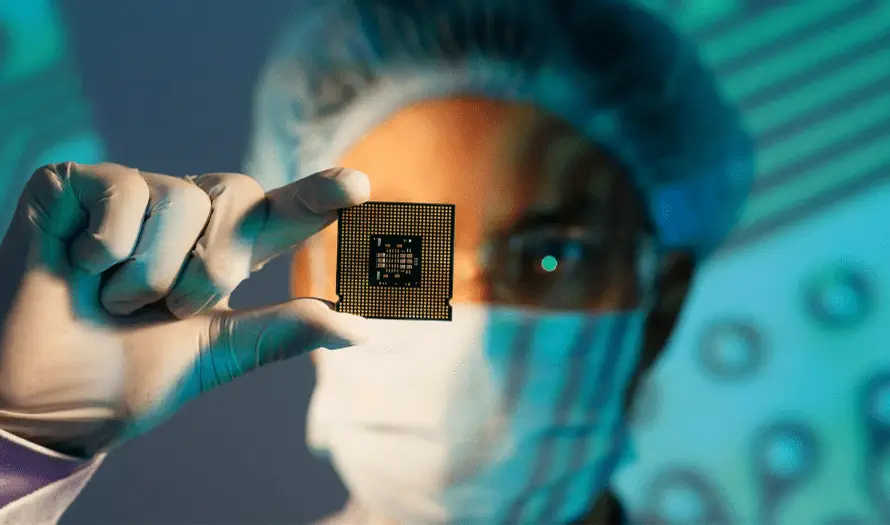Apple M4 Chip journey through technological innovation has continuously pushed the boundaries of what’s possible in computing, with their proprietary silicon chips being pillars of this evolution.
Since the groundbreaking release of the M1 chip, Apple has not just kept pace but has often led the charge in the race for more powerful, efficient computing. As the tech world buzzes with anticipation, the next chapter in this saga will unfold with the upcoming M4 chip.
This new processor is expected to debut in late 2024 and promises to bring even more incredible advancements, particularly in artificial intelligence and machine learning.
This introduction to the M4 chip will explore its development, the technological enhancements it promises, and its potential impact on future Apple products and the broader tech industry.
With the M4, Apple looks set to redefine the capabilities of personal and professional computing once again.
Features of Apple M4 Chip
The development of Apple’s M4 chip marks a significant step forward in the company’s ongoing evolution of its silicon technology.
As Apple continues to refine its processor capabilities, the M4 chip is rumoured to integrate advanced technological enhancements, particularly in artificial intelligence.
The M4 chip is expected to be built using the next generation of Taiwan Semiconductor Manufacturing Company’s technology, which might utilize a 3-nanometer process. This smaller, more efficient fabrication process allows for more extraordinary performance and energy efficiency than its predecessors.
One of the key anticipated features of the M4 chip is a significant enhancement in AI capabilities, facilitated by a more powerful version of Apple’s Neural Engine.

The Neural Engine is crucial for handling various machine learning tasks directly on the device, such as facial recognition, augmented reality, and more sophisticated Siri responses.
The M4 chip will likely expand these capabilities, possibly supporting more complex AI tasks that can enhance user experience across various applications.
With each new iteration, Apple has historically improved the performance and efficiency of its chips. The M4 is expected to follow this trend, offering faster processing speeds, better graphics performance, and enhanced power management.
These enhancements promise a smoother and more responsive user experience and longer battery life in portable devices like MacBook Pros and iPads.
Introducing the M4 chip could also broaden the range of applications and tasks that Apple devices can handle. This includes professional-level tasks such as video editing, 3D modelling, and large-scale data analysis, which would benefit from increased processing power and AI capabilities.
The development of the M4 chip is poised to further Apple’s commitment to leading innovation in the tech industry, enhancing the performance and the range of capabilities of its next generation of devices.
Potential Models
With the anticipated release of the Apple M4 chip, various models and configurations are expected to be introduced across Apple’s device lineup. This diversity will cater to multiple computing needs, from entry-level users to high-performance demands.
The M4 chip is rumoured to include an entry-level model, likely designed for more budget-conscious users or devices that do not require intense computational power.
This variant might be found in devices like the lower-end MacBook Air or base model iMac, where efficiency and cost are more critical than cutting-edge performance.
This approach allows Apple to maintain competitive pricing while offering the benefits of its latest silicon technology to a broader audience.
For users requiring more robust performance, the M4 chip is expected to come in additional variants that offer greater power and capabilities. These might include:
These chips are suitable for the majority of professional users and could power devices like the standard MacBook Pro or the mid-tier iMac.
They would balance performance and power efficiency, ideal for software development, professional photo editing, and light video production tasks.
Apple is likely to introduce high-end configurations of the M4 chip for the most demanding tasks, such as high-resolution video editing, 3D rendering, and complex data computations.
These could be included in the high-end MacBook Pro models and possibly the Mac Pro, providing maximum performance, enhanced AI capabilities, and perhaps more excellent memory support.
Aimed at professionals in video production, music production, and software development, these models likely feature the most powerful variants of the M4 chip.
They could include options for expanded memory and enhanced graphics processing capabilities, making them suitable for the most intensive computing tasks.
All these models are expected to be deeply integrated with the next version of macOS, which will likely be optimized to take full advantage of the new hardware capabilities offered by the M4 chip.
This integration will enhance overall system performance and reliability, ensuring a seamless experience for all types of users.
These varied models and configurations of the M4 chip signify Apple’s strategy to cater to a diverse range of computing needs, from everyday tasks to professional-grade applications, ensuring an Apple device is suitable for everyone.
Integration with Apple Products
The integration of the Apple M4 chip across Apple’s product lineup is set to enhance the capabilities and performance of a range of devices, reflecting Apple’s strategy to leverage its proprietary silicon to deliver a unified and efficient user experience.
The new M4 chip is expected to be a central feature in the next MacBook Pro and MacBook Air generations.
By upgrading these popular models with the M4 chip, Apple aims to significantly boost performance, enhance battery life, and provide superior graphics capabilities.
This integration will cater to general users and professionals who require potent machines for video editing, software development, and graphic designtasks.

The iMac and Mac Mini are also anticipated to receive updates featuring the M4 chip. These desktop solutions will benefit from the M4’s increased processing power and energy efficiency, making them ideal for both home and professional environments.
The M4’s enhanced AI capabilities will likely improve functionalities such as voice recognition and real-time data processing, which are crucial for creative and technical workflows.
The Mac Studio and Mac Pro are expected to feature the most robust configurations of the M4 chip for the high-end market, including creative professionals and developers.
These include expanded memory options and enhanced graphical performance, tailored for intensive tasks like 3D animation, complex video effects, and large-scale software compilations.
Integrating the M4 chip into these devices underscores Apple’s commitment to meeting the needs of professionals requiring top-tier computational capabilities. There is also speculation about the M4 chip powering a new line of high-end iPad Pros.
This would represent a significant leap in performance for Apple’s tablet range, allowing them to handle more demanding applications such as augmented reality, professional-grade art and design apps, and even some desktop-class software.
Integrating the M4 chip into the iPad Pro could blur the lines between laptop and tablet capabilities, offering users a portable yet compelling device.
Alongside hardware updates, the M4 chip is expected to be seamlessly integrated with the latest macOS and, potentially, iPadOS.
This integration optimizes system performance and reliability, ensuring that software and hardware are perfectly aligned to deliver the best user experience.
Enhanced AI capabilities built into the operating system could also improve security, system management, and user interface customization, adapting more intelligently to user needs.
This comprehensive integration strategy improves individual device performance. It ensures a consistent and optimized experience across all Apple devices, leveraging the full potential of the M4 chip’s capabilities.
Market Impact
The launch of Apple’s M4 chip is poised to significantly impact the tech market and is met with high consumer expectations. This next-generation processor will likely influence both industry trends and consumer behaviour.
The introduction of the M4 chip is expected to push the boundaries of what is possible in personal computing, particularly with its advancements in AI capabilities.
As Apple integrates this chip across its product lineup, competitors will be compelled to accelerate their own innovations in chip technology, which could lead to a broader range of high-performance, energy-efficient consumer electronics on the market.
Apple’s consistent innovation with its chip technology often sets new standards for the industry.
The M4 chip, with its expected improvements in processing power and energy efficiency, may raise the bar for what consumers expect from their devices, not just in terms of speed and battery life but also in how effectively these devices handle AI and machine learning tasks.
Consumers will likely expect the M4 chip to deliver noticeable improvements in speed and efficiency across devices. This includes faster processing times, quicker app launches, and smoother multitasking capabilities.
For professionals and creatives, expectations will be even higher, with hopes for capabilities that can handle demanding applications like video editing software and large-scale data processing without lag,
Given the advancements in chip efficiency, consumers will also anticipate improvements in battery life. This is particularly significant for mobile devices like the MacBook Air and iPad Pro, where extended battery life can significantly enhance portability and usability.
With the M4’s enhanced Neural Engine, consumers will likely expect advanced AI features, such as improved voice recognition, more intuitive predictive typing, and enhanced photographic capabilities that adjust settings based on the environment.
Consumers will be looking for significant value from the M4-equipped devices. This includes top-tier performance, features, longevity, and support, ensuring that their investment remains viable and effective for years to come.
The release of the M4 chip thus represents not just a technical upgrade but a strategic move by Apple to meet and set consumer expectations and industry standards, further solidifying its position as a leader in technology innovation.
Future Outlook
The M4 chip, with its enhanced AI and machine learning capabilities, highlights a broader industry trend towards integrating sophisticated AI directly into consumer devices.
This trend is anticipated to expand, with future chips likely becoming even more adept at handling complex AI tasks locally on devices, reducing dependency on cloud-based processing.
This shift can improve device responsiveness, enhance privacy, and introduce new functionalities, such as real-time language translation and advanced augmented reality.
As global emphasis on sustainability increases, the tech industry continues to move towards more energy-efficient technologies. Apple’s M4 chip, expected to be built using a smaller and more efficient process, represents this shift.
Future developments will likely focus on reducing power consumption and minimizing the environmental impact of tech products. This trend is significant for reducing operational costs and aligns with consumer expectations for more environmentally friendly technology.
The capabilities of the M4 chip are set to blur the lines further between desktop and mobile computing. As chips become more powerful and energy-efficient, the distinction between what can be done on a desktop and what can be done on a mobile device continues to diminish.
Future trends may include even greater convergence of device capabilities, potentially leading to universal devices that can adapt to various use cases, from mobile to desktop, all powered by a single chipset.
With each iteration of its silicon chips, Apple has sought enhancements that boost performance and device longevity.
Future chip technologies are likely to continue this trend, emphasizing not just peak performance but also the longevity of that performance over time.
This approach could redefine consumer expectations about the device’s lifecycle, influencing purchasing decisions based more on long-term value rather than short-term capabilities.
The advanced hardware capabilities of chips like the M4 will also influence software development, enabling developers to create more sophisticated applications and services.
This could lead to a significant evolution in software offerings, with applications becoming more capable and offering more prosperous, immersive experiences.
The release of the M4 chip and subsequent innovations in chip technology are expected to drive significant shifts in the tech industry, impacting everything from AI integration and environmental sustainability to the convergence of device capabilities and software development.
These trends highlight Apple’s influence and signal the direction of the broader tech industry for years to come.
Final Thoughts
As we anticipate the release of Apple’s M4 chip, it is clear that this advancement is not just a step forward for Apple but a leap for the entire tech industry.
The M4 chip, with its expected improvements in AI capabilities, processing power, and energy efficiency, is set to redefine personal computing, push the boundaries of what mobile devices can achieve, and set new standards for technological environmental sustainability.
This progression highlights Apple’s ongoing commitment to innovation and its influence in shaping future tech trends.
The integration of the M4 chip across Apple’s product range—from MacBooks and iMacs to potentially iPads—illustrates a future where devices are more powerful and efficient and more interconnected and capable of handling complex tasks with ease and precision.
The M4 chip’s impact extends beyond hardware. It is poised to influence software development, leading to more sophisticated applications and providing consumers with more prosperous, immersive digital experiences.
As AI and machine learning become more integrated into our daily devices, the potential for personalization and efficiency in technology usage becomes boundless.
The M4 chip is more than just a technological upgrade; it is a harbinger of the future of computing. As Apple continues to lead with such innovations, the tech industry is inspired to follow suit, paving the way for a future where technology enhances human capabilities and experiences.
As consumers, our expectations are not only about what technology can do today but what it promises for tomorrow.


